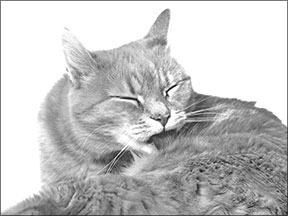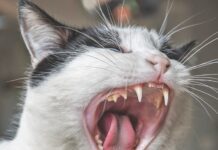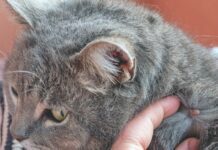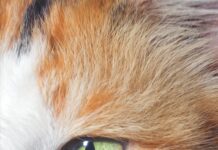Some cats lick so much they take their fur off down to bare skin. They’re what veterinary dermatologist William H. Miller, Jr., VMD, at Cornell College of Veterinary Medicine calls fur mowers. “If the animal licks without too much vigor, the licked area will be hairless but not inflamed or infected,” he says, “but with more passion, the skin can be abraded and might become infected.”

Excessive licking is a sign of one or more of at least three problems, Dr. Miller says: the licked area is itchy, the licked area is painful or the animal has a behavioral issue. These broad areas leave many possibilities.
Cats can suffer from skin disorders and painful conditions such as arthritis or illnesses that trigger pain. And while behavioral skin disorders are uncommon, obsessive licking must be considered. (See sidebar.)
Thyroid Impact. “A cat licking near his tail head could have anal sac disease, among all the other reasons for licking,” Dr. Miller says. “Fleas are a biggie. Environmental allergies are a possibility. Some hyperthyroid cats will lick excessively for no apparent reason. Once the thyroid disease is resolved, the licking stops.”
A veterinary examination is necessary to determine the cause. “Thousands of different things must be considered,” Dr. Miller says. “For instance, if the licking isn’t triggered by behavior or pain, then all the various itchy skin diseases are fair game. First and foremost, the cat needs a good history and physical examination.”
In addition, the veterinarian will ask about diet, medications or supplements, your observations about his licking behavior, daily routine, changes you may have noticed, a description of your home environment, new detergents or cleaning products and the other pets in the home perhaps showing similar signs.
The physical exam will include evaluating the body and coat condition, checking the ears, joints, bones and other areas for swelling, pain or parasites, and palpating the abdomen to assess the abdominal organs.
The itchy area may offer a clue. “If pain is the underlying cause, the area licked usually is very focal or regionalized,” Dr. Miller says. “For example, a cat with arthritis might lick the painful area before the signs of lameness or pain become obvious to the owner.”
Top Contenders. The history and exam can whittle the list of possible diseases to three or four top contenders. Laboratory tests may then be necessary. They might include skin scrapings, a fungal culture or blood work if an underlying disease is suspected.
Once the cause is identified, treatment may be as simple as a flea preventive, or it may require more detective work, such as putting the cat on an elimination diet to determine if a certain ingredient is making him itch or switching to an unscented detergent. Analgesics can be prescribed for arthritis or other painful conditions.
Identifying the cause of excessive licking can take time and patience. With treatment, however, your cat can return to normal. ❖
WHEN OVER-GROOMING IS THE REASON
Compulsive disorders in cats are uncommon, usually affecting Siamese and other Oriental breeds. When cats lick themselves excessively, the cause is almost always medical, says behaviorist Katherine A. Houpt, VMD, Ph.D., emeritus professor at Cornell. “They might be stressed in the household, but a study shows that most of them have some other medical cause such as a parasite (fleas) or allergies.”
Excessive licking and hair loss due to psychological problems is a rare condition known as psychogenic alopecia or, more commonly, over-grooming. It may also be described as a compulsive disorder. Licking releases endorphins, natural painkillers made by the brain that soothe anxiety.
Determining if a cat has a compulsive disorder is a process of elimination. It starts with ruling out medical reasons such as neurological diseases that might cause pain, discomfort or changes in sensation, as well as skin diseases or allergies.
If no medical cause is found, your cat’s veterinarian may refer you to a behaviorist or a certified applied animal behaviorist. The behaviorist will ask about your cat’s diet, activity levels, environment, other pets in the home and interaction with other pets and family members. Common causes of stress are the presence of a new family member or conflicts with other animals.
In the event that excessive licking is determined to be compulsive behavior, you may need to reintroduce pets in the household and make more positive associations between them, provide a consistent routine or enrich the cat’s environment with a tall post for climbing, more playtime, food puzzles and treat balls. In severe cases, anti-anxiety medication may also help.
Most important, never punish the cat for the behavior. That can be counterproductive or even unintentionally cruel, Dr. Houpt says.



